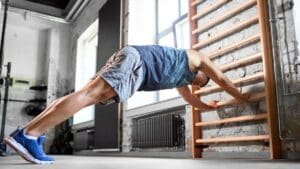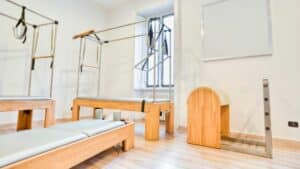
If you wake to tight, sore and tender muscles after your epic leg day, consider it a badge of honor—and a gentle reminder that recovery deserves your attention.
Rest is just the beginning; true recovery is a vital component of your training regimen, essential for building strength and enhancing performance. As your muscles heal from the microscopic tears that cause DOMS, knowing exactly how to recover from leg day is key to getting back on your feet.
Here is your quick guide to shaking off the post-squat blues. We’ll walk you through effective methods to soothe your soreness, enhance muscle repair, and restore your mobility swiftly. Follow these proven post-workout recovery tips and you’ll bounce back quicker from those brutal muscle-burning leg days.
Nutrition: Fuel Your Recovery
Proper nutrition is critical for muscle recovery after intense leg exercises. Here are some key nutrient tips:
Protein Intake: Consuming 15-25 grams of protein after a workout helps repair those tiny tears in your muscles, speeding up recovery and promoting growth. Lean protein sources like chicken, fish, Greek yogurt and protein powder are great options.
Carbohydrate Consumption: Replenishing your glycogen stores with healthy carbs post-exercise enhances recovery. Focus on complex carbs like quinoa, oats and sweet potatoes.
Additionally, timing your nutrition correctly can further boost muscle repair:
- Pre-workout: Have a light protein snack like an egg or Greek yogurt 30-60 minutes prior to exercising. This enhances muscle protein synthesis.
- Post-workout: Consume protein and carbs within 30 minutes after your workout. This optimizes muscle repair and glycogen replenishment.
- Before bed: A small protein snack 30 minutes before bed maintains elevated muscle protein synthesis as you sleep.
Rest: Give Your Legs a Break
After leg day, it’s important to give your muscles a break. Simply sitting and relaxing with your legs elevated can aid recovery. Prop your legs up on a pillow or ottoman while reading a book, watching TV or listening to music. This rest time takes pressure off your lower body while allowing blood to circulate and nourish your muscles. A short 15-20 minute legs-up break post-workout does wonders.
Hydrate: Drink Plenty of Water
Your body’s hydration plays a crucial role in your leg day recovery, so make sure you’re drinking plenty of water before and after your workout. Water is essential for maintaining healthy muscle tissue, helping to reduce muscle soreness.
Drinking sufficient water aids in flushing out toxins from your body and supports your kidneys in breaking down lactic acid, a byproduct of your hard work. This helps your legs recover faster.
After workout, rehydration is just as important. Sweating leads to water loss, and it’s vital to replenish your body’s water stores. This assists in the muscle repair process and aids in preventing dehydration, which could slow down your recovery.
Active Recovery: Keep Moving
Continuing on the path of recovery, an active rest day can do wonders for those sore legs of yours. Unlike complete rest, active recovery involves low-intensity, low-impact activities that promote blood flow and speed up the healing process. You might want to consider a gentle swim, a brisk walk, or some light yoga. These activities aren’t strenuous, but they’ll keep your muscles moving and enhance your overall recovery.
Furthermore, active recovery helps flush out lactic acid, a chemical contributor to muscle ache. By keeping your legs lightly active, you’re helping your body to eliminate this waste product faster. Remember, the goal here isn’t to tire yourself out, but to aid your body in its natural recovery process.
You’ll be back to your regular workouts in no time!
Sleep: Catch Zzzs for Muscle Regeneration
When it comes to muscle regeneration, getting a good night’s sleep is one of the most effective things you can do. Your body works hard to repair and build muscle tissue while you’re sleeping. In fact, during deep sleep, your body releases growth hormones that aid in muscle recovery and regeneration.
Not getting enough sleep can hinder this process, leaving your muscles in a state of distress, which can lead to prolonged soreness and ineffective workouts. Aim for at least seven to nine hours of sleep each night.
Quality sleep also reduces stress and inflammation, both of which can negatively affect muscle recovery. So, don’t neglect your rest days and make sleep a priority for optimal muscle regeneration after leg day.
Self-Massage: Roll for Faster Recovery
Self-massage techniques like foam rolling can speed up recovery after leg day by increasing blood flow to sore muscles and helps limit DOMS (delayed onset muscle soreness).
Foam roll your quads, hamstrings, calves and glutes for 30-60 seconds on each muscle group. Roll slowly and focus on areas of tightness. Other self-massage tools like massage sticks, percussion guns, and muscle scraping tools can also provide targeted muscle and myofascial release.
Applying self-massage liberally post-workout enhances circulation, lymphatic drainage, reduces muscle tension, and aids flexibility. With a heated massage gun, you get the best of self-massage and heat therapy. Don’t underestimate the power of DIY massage – it’s easy, affordable and delivers results fast.
Stretch: Maintain Range of Motion
After utilizing massage and myofascial release techniques, the next step in your post-leg day recovery should be incorporating stretching and mobility exercises. These workouts help increase flexibility and range of motion, reducing the risk of injury.
Start with dynamic stretches like leg swings and lunges to warm up your muscles. Then, move onto static stretches such as the hamstring stretch and the butterfly stretch, holding each for 15-30 seconds to really deepen the stretch.
Additionally, mobility exercises like squats and hip raises enhance joint movement. Remember, it’s not a competition – you’re stretching to recover, not to impress. Listen to your body and only stretch to the point of tension, not pain.
Regularly incorporating these exercises can significantly speed up your leg day recovery.
Cold and Hot Therapy: One-Two Punch for Muscle Relief
Understanding when to apply heat or cold therapy can significantly enhance your leg recovery process after an intense workout.
Ice packs or cold water immersion have several benefits for recovery after intense exercise. The cold constricts blood vessels, reducing inflammation and swelling that causes muscle soreness. It’s most effective within 48 hours of a workout. If you’re using an ice pack, you’ll want to use a barrier like a towel between your skin and the cold compress to prevent frostbite. Limit your icing sessions to 15-20 minutes at a time, with breaks in between. It’s crucial not to overdo it, as excessive cold can cause tissue damage.
On the other hand, heat therapy, like a warm bath or heating pad, dilates blood vessels and increases blood flow, helping to relax sore muscles. This is best applied immediately after a workout. Be cautious, though. Applying heat to a fresh injury can actually increase inflammation. Add Epsom salt to your warm bath for bonus recovery points. The salt breaks down into magnesium which helps with muscle cramps. Though research is limited, it’s thought that the magnesium can pass through your skin through hair follicles to get at the muscles. It’s worth a shot.
Immediately after hard training or racing, ice baths seem more beneficial than hot baths for recovery. But don’t over do it. Some studies show that ice baths after a hard workout can actually reduced long-term gains in muscle mass and strength. So for building muscle, avoid ice baths for about 4 hours post-workout. But for runners and other endurance athletes focused on recovery, ice baths shortly after intense sessions are ideal.
Compression Gear: Reduce Swelling and Muscle Pain
Wearing compression gear like socks or leggings can help reduce swelling and inflammation, increase blood flow, and speed up recovery after leg day. The gentle squeezing pressure of compression gear improves circulation to expedite recovery as well as reduces muscle vibration and fatigue during workouts. Compression socks specifically help reduce foot and ankle swelling while compression leggings cover more muscles for overall leg recovery.
Compression boots are another great recovery choice, wrapping your lower body in air-filled sleeves that compress in sequence. They start squeezing from your feet and move up to your hips, improving circulation and lymphatic flow to speed up recovery and ease fatigue after intense activities.
Wearable Tech: Track Your Recovery
Incorporating wearable fitness trackers and smartwatches into your routine provides valuable insights into your body’s recovery process. These devices monitor metrics like heart rate variability, sleep quality, and activity levels. Tracking your recovery data over time helps you understand your body’s unique needs.
For example, if your resting heart rate is elevated, you may need more rest. Or if your sleep data shows disruption, improving sleep hygiene could speed up recovery. Leveraging wearable tech provides actionable data to optimize training, avoid overtraining, and support muscle recovery. So take advantage of the latest technology to enhance your performance.
Quickest Way to Recover After Leg Day – Step by Step
We know that’s a lot of recovery information to take in all at once. Here is our simple, abbreviated list of steps for maximum recovery. Follow these immediately after your workout and you’ll be set up for success:
- Hydrate with electrolytes: Drink water and an electrolyte sports drink immediately after your workout to rehydrate and replace depleted minerals.
- Consume protein + carbs: Eat a nutritious meal containing quality protein and complex carbs within 30 minutes post-workout. This optimizes muscle repair.
- Foam roll: Use a foam roller on your legs for 10-15 minutes to increase blood flow to fatigued muscles. Focus on tight spots for myofascial release.
- Ice and elevate legs: Sit or lie down and raise your legs above heart level. Apply ice packs wrapped in towels to your quads, hamstrings and calves for 15 minutes to reduce inflammation.
- Compression gear: Wear recovery socks or tights after your workout and even to bed to speed up recovery.
FAQ on How to Recover from Leg Day
What not to do after leg day?
Avoid these things after you work those legs:
- High intensity cardio – Can exacerbate muscle damage before you’ve recovered.
- Alcohol – Alcohol is dehydrating and inflammatory. Avoid it or limit intake.
- Skipping post-workout nutrition – Don’t neglect protein and carb replenishment.
- Sitting for too long – Get up, walk around and stretch to prevent lactic acid buildup.
- Applying heat too soon – Wait 48 hours after workout before using heat therapy.
- Massage or foam rolling too intensely – Use lighter pressure and avoid painful areas.
- Skipping cool down – Gently stretch and walk after your workout.
How long should I wait between leg day workouts?
It’s ideal to allow 48-72 hours between hard leg workouts to give your muscles adequate recovery time. You can do light cardio or exercise other muscle groups in between.
Should I workout if my legs are still sore?
It’s okay to workout if you have mild muscle soreness. But if you are still very sore or fatigued, take an extra rest day. Listen to your body. If you need to get in a sweat, try sauna. You’ll sweat, get your heart rate up, and you’re still resting those muscles.
How can I tell if I’m overtraining my legs?
Signs of overtraining include elevated resting heart rate, chronic muscle soreness, fatigue, irritability, and decreased performance. Vary your training, allow for rest days, and monitor your recovery.
Is a protein shake or recovery drink okay for recovery?
Let’s be honest – we don’t always have the perfect recovery meal prepped after leg day. Fitting in a workout can be hard enough without meal prepping.
While whole foods provide superior nutrition, a quality shake is better than nothing. Look for decent protein and carb sources.
Long term, lean protein, veggies, fruits and whole grains are best. But when you’re rushing from the gym, a shake gets nutrients in fast. Don’t let lack of meal prep sabotage your gains.
Final Thoughts on Leg Day Recovery
Now you’re armed with expert-backed tips on how to recover after leg day. No more waddling around for days post-workout. Follow this advice – like refueling properly, elevating, compressing, and massaging your worked muscles. Listen to your body and fine-tune your own optimal recovery routine. Be patient, but with these strategies you’ll bounce back faster. Soon you’ll crave that sweet muscle burn, knowing you’ll have your legs back in action in no time. Recovery is the key ingredient for continual gains and progress. So embrace it, and you’ll be dominating leg day in totally rebuilt and invincible legs.



